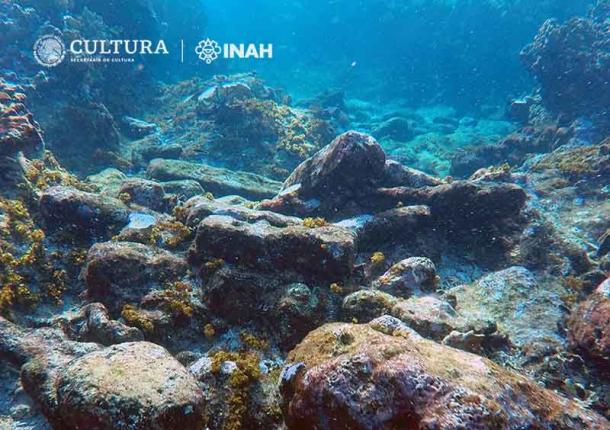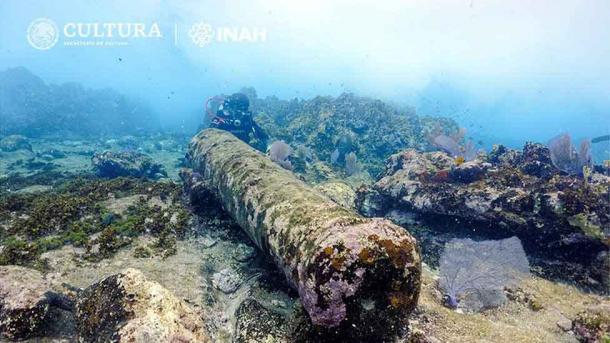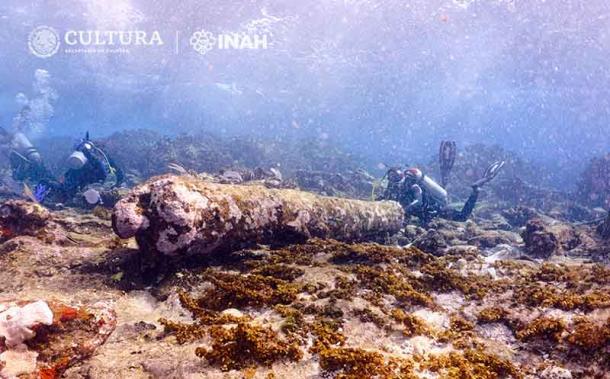Last year maritime archaeologists in Mexico dived into the wreck of a 200-years-old British ship after it was neglected for almost two decades. But as soon as the current Covid-19 restrictions ease the ship will be explored once more, in an effort to finally identify it.
The wreck was originally reported in the late 1990s by a local fisherman named Manuel Polanco, who gave it the name “ El Ingl és” (The English). Polanco discovered the ship on the Banco Chinchorro reef, a treacherous sea monster located about 35 km (22 miles) from the eastern coast of Quintana Roo state in Mexico’s Yucatán peninsula, near Belize. The wreck was explored by divers from Mexico’s National Archaeological Institute (INAH) for the first time last year, after which it was renamed the “ Manuel Polanco,” in the finder’s honor.

The British ship is known as “Manuel Polanco,” in honor of the finder. ( Laura Carrillo Márquez/INAH )
According to a 2020 Daily Mail article about the fate of the ship, the Banco Chinchorro atoll is located on a major historical trade route between Colombia and Spain via Havana, Cuba. Representing “the largest coral atoll in the northern hemisphere,” this singular reef has wrecked so many ships it is known to mariners as the “Dreamcatcher,” “Sleep Depriver,” and “Nightmare” reef.
Anchor Evidence Suggests British Ship Met a Horrific End
An article in PorEsto says the team of divers have so far recovered 70 shipwrecks on the Banco Chinchorro reef. However, only nine have been identified, and with so many lives having been lost at this location the reef is now a UNESCO Underwater Heritage Site. The divers who explored the Manuel Polanco last year discovered many metallic artifacts, including iron ingots that were probably used for ballast, a 2.5m-long (8ft) cannon, and an anchor. Samples from the wreck’s wooden hull were dated back to the late 18th or early 19th century.

The cannon of the wreck is approximately 2.5m in length. ( Laura Carrillo Márquez/INAH )
Laura Carrillo Márquez, SAS researcher and head of the Banco Chinchorro Project, told press last year that the wreck lies directly on the reef barrier “where the ocean current is strong.” Furthermore, she said “Only the solid elements remain, encrusted into the reef.” The researcher said it was the design of the ship’s anchor, known as “the Admiralty Pattern,” that suggested that it was British.
Furthermore, evidence suggested the anchor was “live” when the ship ran aground, and this means the crew had dropped the anchor while the ship was in motion. Explaining why this occurred, the archaeologists said the anchor was probably activated in a desperate attempt “to halt the ship’s progress onto the reef, but apparently too late,” according to the PorEsto report.
There is “Slacking,” and There is “Taking The Micky”…
While diver Manuel Polanco is now retired, in the ’60s and ’70s he found the remains of several shipwrecks on the Banco Chinchorro, including “40 Cañones” and “The Angel.” The INAH researchers said the local fishermen are the ones who “know Chinchorro best” because they navigate the reef daily to earn their living. The Caribbean fishermensail out and anchor over the reef and they dive for lobsters and conch, which they sell in Mahahual or Xcalak. The researchers say these fishing traditions mean it is inevitable that the divers find submerged archaeology from time to time.
Underlying this entire article there is a point of contention that cannot be left unaddressed. It can only be supposed that in a country dealing with the discovery of 200 mammoth skeletons at 13,500 to 20,000-year-old hunting sites, and giant medieval obsidian eagles, there is little interest in the relatively mundane “industrial history” associated with the 19th century English wreck. This assumption is based on the fact that diver Polanco first reported the wreck to archaeologists the early 1990s: yet the first of only two dives wasn’t undertaken until 2020.
However, once the current restrictions ease the archaeologists plan to return to the British shipwreck, to try and identify it once and for all, taking the mystery out of this ghost ship of the Caribbean.

Once the current restrictions ease the archaeologists plan to return to the British shipwreck. ( Laura Carrillo Márquez/INAH )
Top Image: Underwater archaeologists exploring vestiges of a British ship wrecked more than 200 years ago in the waters of Quintana Roo. Source: Laura Carrillo/ SAS-INAH
By Ashley Cowie
 RSS Feed
RSS Feed















 February 7th, 2021
February 7th, 2021  Awake Goy
Awake Goy  Posted in
Posted in  Tags:
Tags: 













